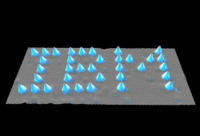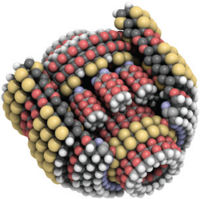Nanotechnology
The advanced automation section has mainly focused on automation technologies using robotics and 'macro'-scale systems, as it describes systems that could be achieved with today's technology. However, even more sophisticated and capable 'nanotechnology' using nano-scale devices  (at the atomic and molecular scale) are likely to be feasible in the coming decades, that could ultimately give us a similar level of control over matter that we currently have over information using computers. See also related Diamond Mechanosynthesis.
(at the atomic and molecular scale) are likely to be feasible in the coming decades, that could ultimately give us a similar level of control over matter that we currently have over information using computers. See also related Diamond Mechanosynthesis.
Please note: as interesting and capable as it is likely to be, advanced nanotechnology is simply not required for the development of an advanced post-scarcity society, which can be achieved with today's technical know-how. So this website focuses on realistic near-term technology.
Having said that, advanced nanotechnology — the ability to make useful machines on the molecular scale — will likely take things to a new level in terms of manufacturing, healthcare and environmental protection, so is certainly worth mentioning.
Nano-scale devices are likely to end up being a mixture of top-down engineering techniques related to current semi-conductor fabrication  and micro-electro-mechanical systems
and micro-electro-mechanical systems  (MEMS), true bottom-up molecular engineering and self-assembly, and derivatives from biotechnology
(MEMS), true bottom-up molecular engineering and self-assembly, and derivatives from biotechnology  . This is likely to give us systems of unprecedented precision, capability and small size that will further revolutionise manufacturing, power generation, agriculture and medicine.
. This is likely to give us systems of unprecedented precision, capability and small size that will further revolutionise manufacturing, power generation, agriculture and medicine.
Nano-scale devices that could be sent inside the human body as a medical intervention are being developed. Mice have already been cured of type-I diabetes with this method[1].
The SXM Project is an open-source hardware project bringing nanotechnology tools to the people. The SXM Project now has a complete, functioning design for one of the two basic tools of nanotechnology: the scanning tunneling microscope, which can scan and manipulate single atoms. The open-source version costs less than €1000, compared to about €11,000 for commercial versions. An open-source atomic force microscope - an evolution of the scanning tunneling microscope - is in the test phase.
Current nanotechnology such as this is limited to simple designs on the nanometer scale (a nanometer is a billionth of a meter). We currently have instruments that allow atomically-precise engineering like this —
This is a picture taken by a scanning tunnelling microscope in 1990. It shows the IBM logo constructed from 35 xenon atoms on a nickel surface. IBM also made this video, showcasing that it is now possible to manipulate single atoms. Atomically-precise manufacturing will hopefully become able to make complex objects like this —
This is a computer-simulated design of a gear, built out of atoms, that could be used to power a nanorobot. As technology progresses in the next two or three decades, we expect to see more and more sophisticated atomically-precise engineering, marking the move from 'nanoparticles' to 'nanorobots'. These tiny robots could be equipped with onboard computers, sensors and artificial intelligence systems and could be controlled by external acoustic signals. They would be about 100 nanometers in diameter (meaning a trillion could be packed into one cubic millimeter). The applications of this technology would be as broad as the applications of computers; few areas of life will be unaffected if and when atomically-precise engineering comes to full fruition. Ray Kurzweil has extrapolated the trends of miniaturization of technology and calculated that this will happen around 2025, which is in line with the nanotechnology industry roadmap's estimate of 2022-2037[2]. Applications of nanotechnology include —
- Turning virtual designs into physical objects. Nanorobots could be designed to construct anything, much in the same way that macro-scale robots do in factories nowadays. Eric Drexler describes here a very conservative design of a molecular assembler that would run on acetone and air, would use 1.3kW of power and would manufacture, at a cost of $1 per kilogram and a rate of 1 kilogram per hour, anything that could be described. This would allow for cheap manufacturing of anything, including all machines now invented, and many things that are impossible to build without nanoscale assembly. The manufacturing would be atomically precise, able to put single atoms in the desired location. This unprecedented accuracy would enable - among countless applications - better fuel cells and capacitors for energy storage, far faster and more compact computer processors, solar cells four or five times more efficient that the ones in use today. We can build superstrong, lightweight materials made from carbon bound together in customized diamond-like structures.
The social effect of such a revolution in technology would be unimaginable. Anyone with manufacturing nanorobots could conjure up any object on their desktop, and this process would be cheap, as the robots would be built mostly from carbon and silicon, which are abundant, and could be made to self-replicate, so there would be hardly any manufacturing costs. It is difficult to imagine a scarcity-based monetary economy surviving in a situation when anyone can make anything for free. - Atomically precise computers could be built at the molecular level, allowing stupendous amounts of computation to be built. Drexler calculates that a computer using mechanical computing at the molecular scale would contain more computing power in each cubic centimeter than a human brain.
- Medicine. Nanorobots are a similar size to a virus, and could be programmed to search-and-destroy any pathogenic virus or bacteria. They could also be used to reverse some of the metabolic damage caused by aging, allowing us to live longer, healthier lives. One nanorobot called a respirocyte has been fully designed and simulated. It is an artificial red blood cell, but transports 236 times more oxygen than natural red blood cells. Calculations show that replacing 10% of your red blood cells with respirocytes would enable you to hold your breath for four hours [3], which would have medical applications as well as making scuba diving a lot more fun. Nanorobots could be sent inside the body to scan it from the inside out.
- Environmental repair. Nanotechnology could be used to eat up oil slicks or repair other environmental damage
- In the home, nanotechnology could create self-cleaning surfaces.


